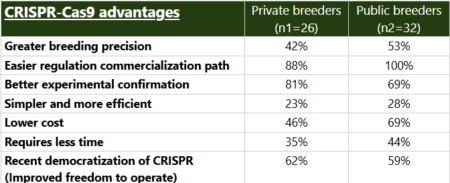Are Canadian plant breeders utilizing the innovations of gene editing?
It would be inaccurate to say that plant breeders in Canada are ‘a dime a dozen’. A rough estimate places the number of professional plant breeders in Canada at 500. Given the recent innovations available to plant breeders, we thought it would be informative to survey this select group about their technology perspectives and uses. As a result, we invited 430 plant breeders from across Canada to participate in a survey on their use of gene editing in plant breeding. With a 22% response rate, from 93 complete surveys, we felt this was enough to give us a glimpse at what is happening in gene editing of plants in Canada.
Gene editing is a plant breeding technology that has rapidly been adopted by plant breeders. Unlike genetically modified (GM) plant breeding technology, gene editing does not insert genes from other plant varieties or species but rather precisely edits the existing plants’ genes. The power to change just one gene can make a significant contribution to a new plant and food crop, as proven with a single gene change in sorghum that resulted in a yield increase of 200%. Our results found that one-third of plant breeders surveyed in Canada are presently using gene editing as part of their crop variety development research. When this response was broken into public and private breeders, there were more public breeders (18 out of 54) are using gene editing technologies than private breeders (11 out of 26). While we didn’t force respondents to identify their uses of gene editing, it appears as though both the public and private sectors are using various gene editing technologies, whether it be meganucleases, zinc finger nuclease (ZFN), transcription activator-like effector nucleases (TALENs), or clustered regularly interspaced short palindromic repeats (CRISPR).
While we know that there is roughly a third of current application towards gene editing technologies, we were interested in learning how many plant breeders anticipate using gene editing over the next 3 years. We found that current to future value doubled to 66%. Of those that anticipated the use of gene editing, we were interested in what plant breeders thought the most significant benefits would be from the use of gene editing technologies. The top advantages expressed by both public and private breeders were the potential for easier regulatory paths to commercialization, the ability to confirm genes of interest, and both the lower cost and access to CRISPR enzymes.

We already know that one of the most significant barriers from genetic modification technologies has been the cost and time to get a new crop variety approved. It is this time constraint, which ultimately prevents public breeders from being able to commercialize new crop varieties In the history of GM crops, there were only two examples of successful publicly developed crops in North America, flax and papaya. As the table above shows, public breeders are unanimous about the potential for gene editing to allow them to use the technologies and commercialize new varieties.
The second and third most significant advantages of gene editing are the improved confirmation that the gene of interest has been successfully changed and that the research can be done cheaper than allowed using existing technologies. Private breeders favoured gene change confirmation, while a significantly higher percentage of public breeders identified cost. At times, public breeder budgets are more constrained than the private sector, which can help to explain why the public sector placed a higher value on this advantage than private breeders.
With breeders identifying lower costs and easier commercialization paths, this is good news for the agriculture industry as this can potentially translate into more new crop varieties, with lower seed prices. Both of the attributes are crucial for agriculture to ensure production is maintained throughout a changing climate.
This blog is a summary of an article that was recently published in The CRISPR Journal and is available at https://www.liebertpub.com/doi/10.1089/crispr.2019.0061
Gleim, Savannah, et al. “CRISPR-Cas9 Application in Canadian Public and Private Plant Breeding.” The CRISPR Journal, vol. 3, no. 1, 2020, pp. 44–51., doi:10.1089/crispr.2019.0061.


